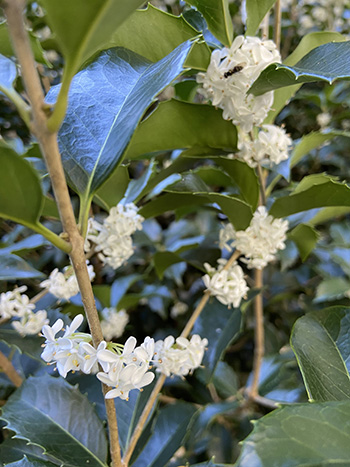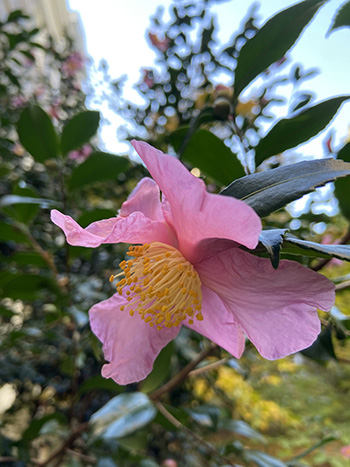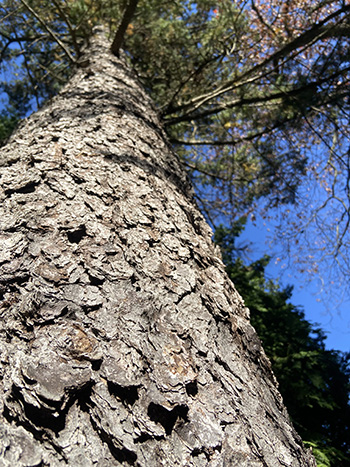
Plants of the Week: Oct. 24

Osmanthus x fortunei ‘Fruitlandii’ (Fortune’s osmanthus)
You’re walking into Parrish from the north entrance when suddenly you encounter a delightful fragrance that stops you in your tracks. You look around but don’t notice anything outstanding that could be causing this pungently sweet aroma. Deciding to get on your way, you enter Parrish Hall and continue with your day, but the memory of that delectable scent lingers in your mind throughout the day.
A subtle plant, the Osmanthus x fortunei ‘Fruitlandii’ delights passerbys without the need for showy flowers or jaw-dropping color. But if you do happen to recognize this evergreen shrub you will notice that it has small, white, four-petaled flowers in clusters along the leaf axils. You may also happen to see that the dark-green leaves on the upper part of the Fortune’s osmanthus have smooth edges while the leaves on the lower branches are toothed.
This plant is best planted where the fragrance can be enjoyed and due to the “pointiness” of its leaves it is frequently used in exclusion hedges and screens. It prefers full sun with moist, well-drained soil and is pollution tolerant. It has a slow growth rate and blooms during mid- to late-fall. Wander on over to the rear side of Parrish Hall across from the Isabelle Cosby Courtyard to experience its lovely scent and subtle nature. Photo credit: M. Rossman

Camellia ‘Winter’s Star’ (camellia)
Once upon a time, a series of cold winters destroyed and/or badly injured most of the camellias at the U.S National Arboretum; a few survived, many perished, but in the midst of this loss, one specimen prevailed. Showing little to no winter injury, the Camellia oleifera (tea-oil camellia) survived the hard winters and became an important species in the creation of cold-hardy cultivars.
One such cultivar is Camellia ‘Winter’s Star’, a cross between Camellia oleifera and Camellia hiemalis ‘Showa-no-sakae’. Getting its cold hardiness from C. oleifera and its lovely pink flowers from C. hiemalis ‘Showa-no-sakae’, Camellia ‘Winter’s Star’ is a tough camellia that blooms in October through November.
Thriving in sun-dappled part-shade under the protection of tree canopies, this specimen also appreciates protection from direct hot summer afternoon sun and from strong winds. To see a good example of this camellia planted in a location well-suited for its needs visit the specimen on the northside of Parrish Hall. Currently this 4-6 foot tall shrub is covered in light pink, six-petaled flowers with a center of bushy yellow stamens. We here at the Scott Arboretum highly recommend installing camellias in the spring so that they have plenty of time to get roots to establish before winter sets in. Photo credit: M. Rossman

Picea pungens (Colorado spruce)
Every December, my folks and I would travel over Battle Mountain Pass in Colorado to a small road pull-off, outside the town of Red Cliff. There, we would cross the road and start trudging through the snow up an old Forest Service road where we would begin our search for our Christmas tree. When I was younger, I remember always calling out to my parents saying, “here, I found the perfect one!” They would take one glance at the tree I had selected and reply that we couldn’t cut that one down because it was a blue spruce – the Colorado state tree.
That is how I eventually learned how to identify and differentiate the Picea pungens from the rest of the needled trees in the White River National Forest surrounding my home. The Picea pungens or Colorado spruce (known to me as the blue spruce) is a wide ranging tree that can grow in Zones 2-7. It is native to the central Rocky Mountains, from southern Montana and eastern Idaho to New Mexico, where it is typically found in locations above 6000-11000 feet in elevation. It has stiff blue-green to silver-blue needles that will let you know when you get too close.
I was surprised to learn that the Scott Arboretum had a specimen located at the top of the Cherry Border. It looks quite different from the stout Colorado spruces that I had known growing up, with their pyramidal shape, as the Scott specimen is very tall with very few lower branches. It is common for spruce trees to lose lower branches with age and this limb loss can be heightened in areas where the Picea pungens experience environmental stress, such as drought, high heat, and humidity. But despite its initial unfamiliarity, I enjoyed this reminder of home. Photo credit: M. Rossman





Robert Roggeveen
Posted at 12:27h, 24 NovemberThis posting – arriving Thanksgiving morning – reminded me to give give thanks for the Scott Arboretum and its staff. I wondered if Megan is home to celebrate.
Alas, while I do a blue spruce, I think the Camellia and the Osmanthus would find my being on the very edge of Zone 6a in Central Connecticut a bit daunting – at least for now..